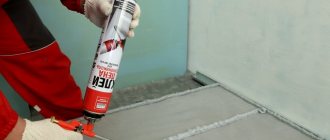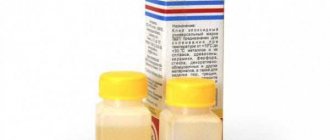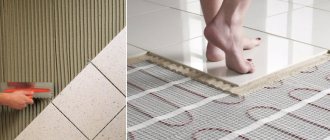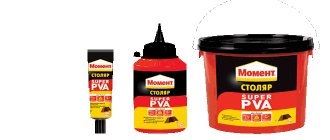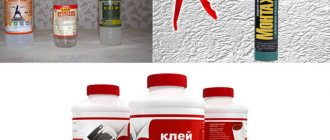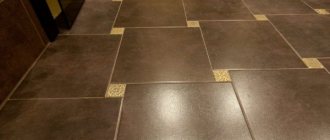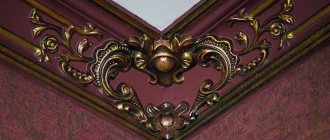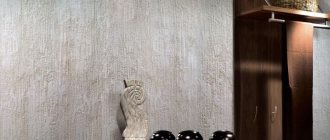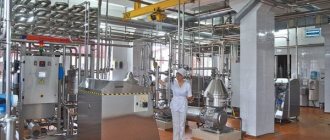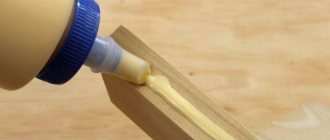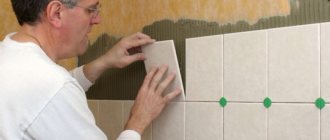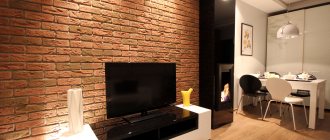Important Never use mixtures that contain toluene, alcohol or acetone for gluing foam plastic, as they destroy the structure of the material. The disadvantage of ready-made adhesives is their high cost. Popular ready-made adhesive mixtures:
- Ceresit ST 84 Express;
- "Titan Stiro 753";
- Penosil.
When deciding how to glue polystyrene foam, you should not write off other ready-made adhesives, for example:
- silicone sealant is used if it is necessary to fasten small fragments of thin foam to a leveled base;
- “liquid nails” is a universal adhesive composition made on the basis of polymers. For example, “Installation Moment”, Dragon, which perfectly connects a metal base with foam. They are convenient for gluing polystyrene foam to the ceiling.
Advice Before gluing, clean the metal surface from rust, grease and paint.
Thermal insulation adhesive Tytan Styro 753 O2
The concept of polystyrene foam: application of the material
The white material with a cellular structure is commonly called foam plastic. It is produced by foaming plastic masses, so it consists of 98% air. Micropores located throughout the entire area of the material are isolated from each other, so the raw material has thermal insulation characteristics. Polystyrene foam is considered an environmentally friendly material; it has a long shelf life and does not ignite without a fire source. Light weight and low cost are the main advantages of this material.
Experienced craftsmen know how to glue foam plastic, so they use it in the following areas:
- insulation of buildings;
- production of refrigerators;
- protection against freezing of various communications;
- roof insulation;
- use for finishing purposes.
Foam material is often used to insulate houses Source 999111.ru
Foam plastic is used for finishing ceilings, walls and other surfaces. It is easy to paint, dries quickly, and does not crack. Cut the material using a sharp stationery or construction knife. It is often used as a base for preparing glue, paint or varnish for concrete or wood.
Fast but expensive
Many compositions require holding the glued slab for some time (sometimes long). How can you quickly glue a thermal insulator, thereby reducing downtime?
“Liquid nails” are used when it is necessary to insulate a small area of a wall made of any material. Before gluing foam to concrete or other material, clean it of foreign deposits and cover it with a layer of primer.
The main advantages of this composition are:
- versatility of use;
- quick installation (long-term holding of the sheet is not required).
The disadvantage would be the fairly high cost, but you have to pay for convenience. “Liquid nails” are sold in 300 ml tubes. Squeezed out of the tube using a sealant gun.
How foam is glued to different surfaces
Depending on the type of work, foam plastic is glued to various surfaces. For example, when fixing to concrete walls, specialists use special foam. Since concrete walls are quite cold, they require insulation, and this material is ideal for this role. Foam glue is suitable when working with brick walls. This composition is a dry mixture, which the master subsequently dilutes with water. Dry mixtures are inexpensive and have low consumption. The specialist applies the finished composition to the wall or to a sheet of material, and the slabs themselves are glued from bottom to top.
Dry construction mixtures are used for gluing Source obystroy.ru
You can use polystyrene foam glue or PVA construction adhesive. It perfectly fixes the material on metal surfaces. First, burlap is impregnated with this composition, applied to a metal surface and waited for drying. As soon as the layer has dried, fix the foam material. In order for the slab to better adhere to the base, after applying it, it is pressed against the wall. At this time, the glue increases its thickness, and the specialist glues the next slab.
Attaching to wood
Polystyrene foam is attached to wood in different ways.
- It has long been known that wood must “breathe”, otherwise rot will appear. Only thanks to the air flow, the tree retains its characteristics for many years.
To protect the wooden wall from rotting, foam plastic is laid with a ventilation gap. For insulation, a lathing is made from wooden blocks. The slabs are inserted between the bars. A vapor barrier layer made of foil film protects the insulation from condensation.
- Special metal nails can securely hold slabs on wooden surfaces. Unfortunately, cold bridges appear at the fastening points, so high-quality putty is required.
When plastic nails , the thermal insulation of the slabs is improved.
- Fastening with adhesives is simple and reliable. The main thing is to choose the right glue that is resistant to changes in ambient humidity and temperature. A solution containing cement and glue has worked well.
How to glue polystyrene foam
Extruded polystyrene foam is a separate type of material, similar to polystyrene foam, but with its own differences. This is a synthetic board raw material that is produced by foaming a polymer composition at the time of extrusion. 95% of polystyrene foam consists of air. The material is light and perfectly retains heat, and also absorbs sounds.
Regular polyurethane foam is suitable for fixation Source vikbud.ua
See also: Catalog of companies that specialize in finishing and paintwork materials
Expanded polystyrene is used to decorate the walls inside and outside the house. Polystyrene adhesive comes in different forms:
- polyurethane - suitable for gluing the material to concrete, stone, wood, brick, metal, expanded clay, plaster;
- adhesive foam – resistant to moisture and aging, used for insulating facades from the outside;
- cement-mineral - available in dry or ready-made form, resistant to frost, therefore used for insulating the external wall;
- based on modified bitumen - suitable for fixing the material on brick, metal, stone and wood, relevant for outdoor work.
Before using the adhesive, the slabs are cleaned of debris, and the walls are prepared for work - dust and dirt are removed. Then glue is applied to the slab, pressed tightly against the wall and left for several minutes. The plate is released, meanwhile the glue sets, so the master can already work with the next polystyrene plate.
Adviсe
- When choosing glue , give preference to trusted brands and manufacturers.
- Pay attention to the packaging. It must have an environmental label. This is the only way you can be sure that the glue is safe for human health.
- Select the composition based on the type of work to be performed - internal or external.
- Do not choose glue with an expired sell-by date.
- Do not purchase damp bags. The glue should be stored in a dry and warm place.
- When purchasing glue , do not be guided solely by its cost. A low price hardly indicates a high quality composition.
How to glue foam together
It has already been found out how to glue foam plastic to other types of surfaces, but fixing two identical sheets also has its own nuances.
Polymer adhesives are suitable for fixing sheets together Source sevparitet.ru
There are several compounds that help with fastening:
- Liquid nails are a strong composition, so specialists connect the parts as smoothly as possible.
- Polyurethane spray - sprays evenly onto the slab and sets quickly.
- Professional glue – ensures a strong seam.
- PVA is the most affordable option, suitable for interior decor.
- Polyurethane foam – fixation occurs within 40-60 minutes.
Before gluing the foam together, builders clean the material from dust and wipe it with a dry rag. Next, prepare the walls, making them smooth and uniform. Two slabs of polystyrene foam are covered with glue and fixed one by one on the wall. Press down a little and wait until the solution sets. The optimal time that craftsmen use to press the slabs is 60 seconds, then the material is left to dry.
Fastening to concrete and brick walls
Often, to insulate concrete and brick walls, a special sheathing is made that holds foam plastic slabs. Unfortunately, it is not always possible to install it, and in addition, additional costs arise. In practice, other fastening methods are in demand.
- Using adhesive.
This method has its own peculiarities. Firstly, individual components of the adhesive can destroy the foam, and secondly, not every stickiness of the adhesive composition will bind the foam to concrete and brick.
The insulation boards are fastened in a certain sequence:
- the surface is leveled, then dirt and oil deposits are removed from it;
- The glue components are connected according to the instructions. The resulting composition should not contain water, then it will not come off for a long time;
- the adhesive is placed on the slab in separate sections so that there is space for air to escape;
- the insulation is pressed and held.
- Using dowels.
Foam plastic as a basis for adhesives
A strong adhesive is made from polystyrene foam or expanded polystyrene to hold surfaces together. This composition can also be used as a paint or protective varnish. Based on small, light balls, the adhesive solution is strong and reliable.
Foam material produces a powerful fixing mixture Source i1.wp.com
Polystyrene foam adhesive
This solution has good adhesive properties and is used in the following cases:
- for sealing cracks and joints in the roof;
- for gluing interior items;
- for decoration of household products;
- for fixing ceiling plinths;
- for joining individual pieces of polystyrene foam.
Styrofoam glue becomes a lifesaver when there is no construction adhesive nearby. Experts make it themselves. They take a solvent such as xylene, acetone or gasoline. Gasoline dissolves foam perfectly, so it is considered the optimal component for glue. Then take pieces of polystyrene foam or expanded polystyrene: the larger they are, the more viscous the finished solution is. Polystyrene foam is gradually placed in a jar of solvent and the workpiece is stirred. As soon as the glue is ready, it is immediately used for its intended purpose.
The solvent instantly corrodes the foam Source mauro-gianvanni.ru
This composition is not stored for a long time, so it must be used immediately. Glue is applied to the surface and the desired material is glued. Experts make sure that there are no smudges on the product: ingrained composition is very difficult to wipe off after it dries.
Ceiling mount
The main condition for such fastening is high-quality preparation of the ceiling, which includes cleaning of whitewash and dirt, as well as laying electrical wiring.
The foam is attached in one of the following ways:
- Frame method.
The sheathing or frame for the ceiling is made of wooden blocks. In order not to cut the slabs, it is recommended that the size of the sheathing cells be shaped to match the size of the sheets.
Inside the cells, foam is attached with glue or fungi. All gaps are sealed.
We seal the gaps with foam
A vapor barrier film is placed on top of the insulation, which is held on the sheathing.
At the final stage, plasterboard sheets are attached to the ceiling.
- Glue method.
This method is much cheaper than the one discussed earlier. The main thing is to choose and prepare the adhesive composition correctly.
When preparing the ceiling surface, in addition to cleaning, it is coated with a disinfecting solution and primer. When it is not possible to completely remove the whitewash, the entire ceiling is covered with an adhesive composition.
Glue is applied to the slab in broken lines. The slabs are laid from the middle of the ceiling with a shift.
Dowels are used for additional fastening.
A reinforcing mesh is attached to the laid insulation on top, which is then puttied and processed.
Requirements when choosing glue
Expanded polystyrene has long been valued by builders for its low thermal conductivity and resistance to moisture. Also, mold cannot grow. Sound insulation is excellent, as well as biological stability (not afraid of salts, acids, alkalis).
Polystyrene burns as long as it is in contact with an open flame. After cessation of exposure, the material completely self-extinguishes within 4 seconds.
Service life up to 30 years. Withstands exposure to many chemicals. But for some it becomes completely unstable.
Contact of the material with chemically aggressive substances is prohibited:
- organic solvents: acetone, turpentine, ethyl acetate and other paint solvents;
- saturated hydrocarbons: alcohol;
- petroleum products: diesel fuel, gasoline, fuel oil, kerosene.
These media dissolve foam upon exposure. Therefore, when purchasing glue, you should carefully ensure that it does not contain these ingredients.
Also, when choosing the adhesive composition, the following are taken into account:
- what kind of work is needed (external or internal);
- what surface the insulation will be glued to (metal, wood, concrete).
Structural foam is available in a variety of thicknesses. It is easy to apply any composition to a flat surface. They are very light, so gluing them is easy and quick.
Required Tools
The set of tools and auxiliary materials required for gluing foam depends on the fixing agent used. In any case, you should prepare:
- polystyrene foam of the selected thickness, its quantity should be equal to the area that needs to be covered plus 10% for waste;
- a small spatula and a rag to remove excess adhesive mass; if they are not removed, hard lumps will form;
- a primer for treating the main surface to which the foam will be attached;
- wide primer brush;
- knife for cutting foam.
If you plan to additionally secure the slabs with dowels, then you need:
- hammer drill with 10 mm drill;
- hammer;
- special dowels shaped like umbrellas (fungi).
Installation of polystyrene foam on the balcony
When using a dry mixture, the following is additionally required:
- tap water;
- plastic mixing container;
- construction mixer (drill attachment);
- spatula-comb for applying the composition to the foam.
If aerosol glue is used, then a special mounting gun is required into which the can is inserted.
